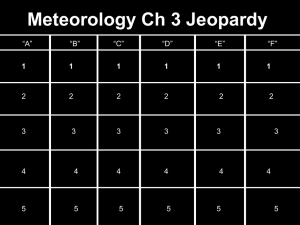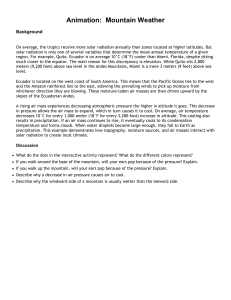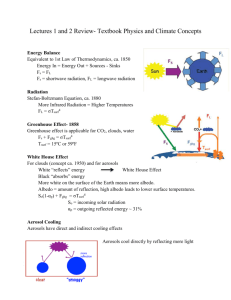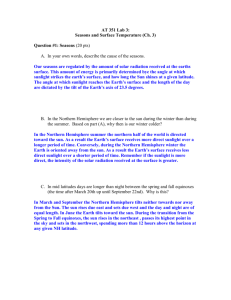Meteorology Chapter 3 Worksheet 2 Name: Circle the letter that
advertisement
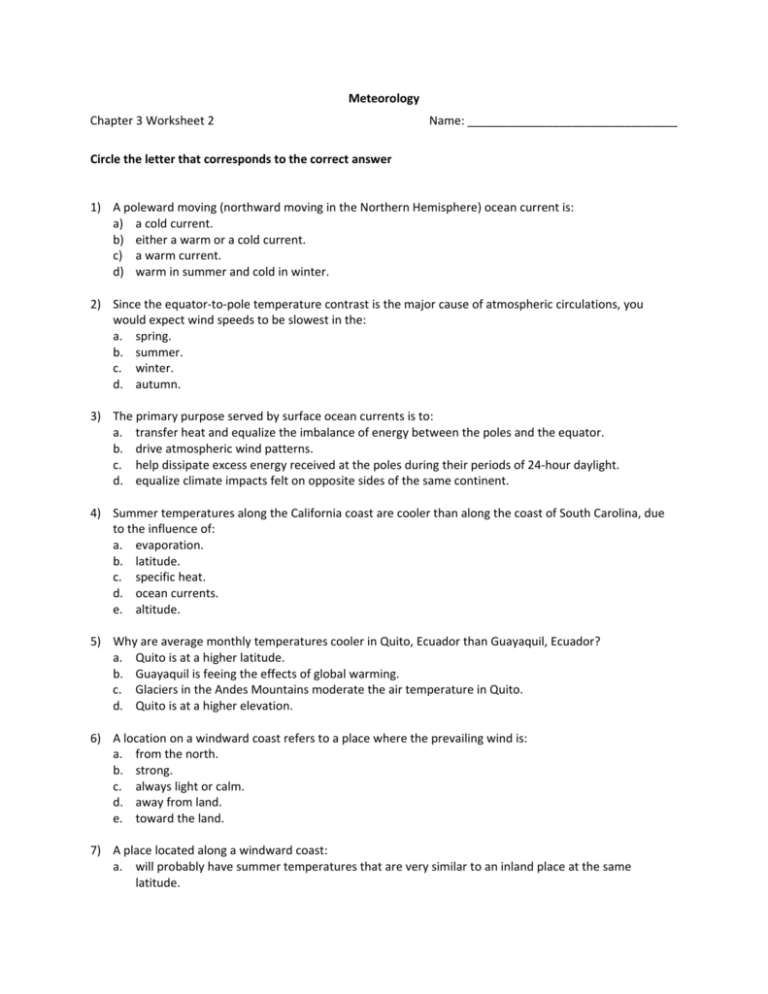
Meteorology Chapter 3 Worksheet 2 Name: ________________________________ Circle the letter that corresponds to the correct answer 1) A poleward moving (northward moving in the Northern Hemisphere) ocean current is: a) a cold current. b) either a warm or a cold current. c) a warm current. d) warm in summer and cold in winter. 2) Since the equator‐to‐pole temperature contrast is the major cause of atmospheric circulations, you would expect wind speeds to be slowest in the: a. spring. b. summer. c. winter. d. autumn. 3) The primary purpose served by surface ocean currents is to: a. transfer heat and equalize the imbalance of energy between the poles and the equator. b. drive atmospheric wind patterns. c. help dissipate excess energy received at the poles during their periods of 24‐hour daylight. d. equalize climate impacts felt on opposite sides of the same continent. 4) Summer temperatures along the California coast are cooler than along the coast of South Carolina, due to the influence of: a. evaporation. b. latitude. c. specific heat. d. ocean currents. e. altitude. 5) Why are average monthly temperatures cooler in Quito, Ecuador than Guayaquil, Ecuador? a. Quito is at a higher latitude. b. Guayaquil is feeing the effects of global warming. c. Glaciers in the Andes Mountains moderate the air temperature in Quito. d. Quito is at a higher elevation. 6) A location on a windward coast refers to a place where the prevailing wind is: a. from the north. b. strong. c. always light or calm. d. away from land. e. toward the land. 7) A place located along a windward coast: a. will probably have summer temperatures that are very similar to an inland place at the same latitude. b. will probably have warmer summer temperatures than an inland place at the same latitude. c. will probably have cooler summer temperatures than an inland place at the same latitude. 8) How is the daily maximum temperature affected by the presence of clouds? a. cooler b. no conclusive effect c. warmer during day, cooler at night d. warmer 9) How is the daily temperature range affected by the presence of clouds? a. The temperature range is greater when clouds are present. b. The temperature range is lower when clouds are present. c. The temperature range is not affected by the presence or absence of clouds. d. Temperature range is not affected in a predictable way by the presence of clouds. 10) What type of severe weather event killed up to 35,000 people in Europe during the summer of 2003? a. a heat wave b. a drought c. a tornado outbreak d. a flood on the Elbe River 11) Heat waves are usually more severe in: a. large urban areas. b. very rural areas. c. coastal areas. d. no one particular place; they are equally severe everywhere. 12) The annual temperature range at most latitudes in the southern hemisphere is much smaller than in the northern hemisphere. Why? a. Rainfall and cloudiness are greater in the southern hemisphere. b. Earth is closer to the Sun during southern hemisphere summer. c. There is more area covered by water in the southern hemisphere. d. There is less desert area in the southern hemisphere. e. There is more mountainous area in the southern hemisphere. 13) The annual temperature range is quite small near the equator. This is true primarily because: a. solar radiation is nearly uniform all year. b. the earth emits more infrared energy at these locations. c. low pressure systems are almost never present. d. the elevation of most land areas there is near sea level. e. wind speeds tend to be always slow. 14) Locations on Earth which have the largest annual temperature change from summer to winter are often: a. near an ocean. b. very humid. c. at the equator. d. at high latitudes. e. at low altitudes. 15) The most important cause of temperature variations is: a. altitude. b. differences in receipt of solar radiation. c. cloud cover and albedo. d. differential heating of land and water. e. ocean currents. 16) Temperatures at the Earth's surface tend to DECREASE when solar radiation: a. is less than Earth's longwave radiation. b. exceeds Earth's longwave radiation. c. is equal to Earth's longwave radiation. d. is increasing. 17) The minimum temperature usually occurs near sunrise because: a. atmospheric path is longest. b. the Sun angle is lowest then. c. reflection of solar radiation is a maximum. d. Earth experiences a net loss of radiation until then. 18) Daily and seasonal temperature cycles depend primarily on: a. the combined effects of solar and terrestrial radiation. b. only solar radiation. c. only terrestrial radiation. d. distance from the Sun. e. friction between the wind and Earth surface. 19) The lag of extreme temperatures with respect to minimum or maximum values of solar radiation is due to: a. the earth being covered mostly by water. b. the rotational motion of the earth. c. the influence of the total radiation balance d. absorption within the atmosphere e. the elliptical orbit of the earth. 20) The lag of the maximum is exhibited when: a. the maximum temperature during a year does not occur until autumn. b. the highest levels of solar radiation are not received until late afternoon. c. the maximum temperature for the day occurs several hours after maximum solar radiation receipt. d. the warmest annual mean temperature occurs in the year following maximum CO2 emissions. 21) An energy surplus in the atmosphere from solar radiation occurs: a. between sunset and midnight. b. in the early afternoon. c. in the morning. d. between midnight and dawn. e. exactly at midnight. 22) The daily maximum temperature occurs at the time: a. when incoming radiation first exceeds outgoing radiation. b. of maximum incoming radiation. c. when outgoing radiation equals incoming. d. near noon. 23) Overnight temperatures are warmer when the air is humid because: a. water vapor is a good absorber of outgoing longwave radiation. b. water vapor is a good absorber of incoming shortwave radiation, causing more energy to be stored during the day. c. water vapor and clouds cause the Earth system to have a higher nighttime albedo. d. water vapor is good at scattering longwave radiation. Circle “T” if the statement is true of “F” if the statement is false T F 24) The California coast is influenced by a cold ocean current. T F 25) The daily temperature range is greater at higher elevations. T F 26) The influence of altitude upon temperature results in surface temperatures falling more rapidly with height than the normal lapse rate value. T F 27) A leeward coastal city will display climate patterns typical of a continental climate, even though they are located on the coast of an ocean. T F 28) Cloud cover reduces both the daily high and daily low temperatures. T F T T T T T T F F F F F F 29) Clouds have a significant influence on surface temperatures because they absorb most solar radiation. 30) The seasonal shift of isotherms is greater over the continents than over the ocean. 31) Isotherms are more irregular in the Southern Hemisphere than in the Northern Hemisphere. 32) Latitude is a major control of temperature since latitude determines the Sun angle. 33) The daily range of temperatures depends only on the amount of solar radiation received. 34) During a typical day, the lowest temperature usually occurs about midnight. 35) Air temperature drops when the rate of terrestrial energy loss is less than the rate of solar energy gain. Answer the following questions 36. Less water is available for evaporation in cities. Why is this so? 37. In addition to a good quality thermometer, list three factors that are needed to obtain an accurate temperature reading.

